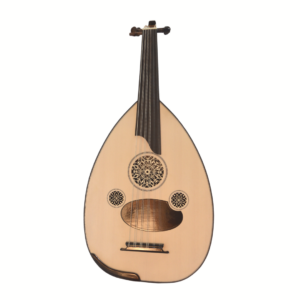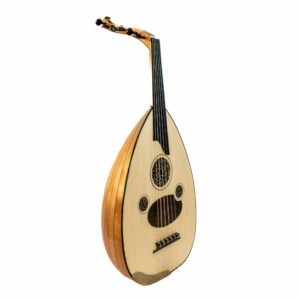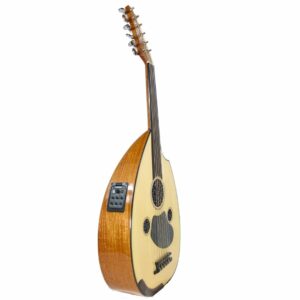- Call us
- Via Vicolo Galletti 2 , 48013 Brisighella (RA) / Italy
- WORLDWIDE FREE SHIPPING
Oud
Explore the Enchanting World of Oud
If you have a passion for ethnic musical instruments, especially the oud, you’ve come to the right place! The oud is a traditional instrument originating from the Middle East, and its soothing and mesmerizing tones have captured the hearts of countless musicians.
The oud has a rich and ancient history deeply intertwined with the musical heritage of the Middle East and North Africa. It can be classified into two distinct types: the Arabic oud and the Turkish oud. Despite sharing common origins, these ouds possess remarkable differences that shape their individual sounds and cultural significance.
Let’s delve into the distinct features of each:
The Arabic Oud:
The Arabic oud holds a revered status as an iconic instrument in traditional Arab music, showcasing the following traits:
Construction and Design: The Arabic oud features a larger body with a deeper bowl, setting it apart from the Turkish oud. Crafted from materials such as spruce or cedar, its resonant soundboard complements the back and sides made of rosewood or walnut, enhancing its warm and rich tones.
Strings: Traditionally, the Arabic oud is equipped with 11 strings, although variations with additional strings are not uncommon. The strings, made of nylon or gut, are arranged in courses, offering a wide range of melodic expressions.
Playing Techniques: Playing the Arabic oud involves employing unique techniques such as using a risha (plectrum) and fingerpicking. The risha is used to pluck the strings, creating rhythmic patterns, while the fingers produce melodious phrases and ornamental flourishes. These techniques contribute to the distinct melodic and rhythmic qualities that are emblematic of Arabic music.
The Turkish Oud:
The Turkish oud holds great significance within the rich musical heritage of Turkey and has gained popularity beyond its borders. Here are some notable features of the Turkish oud:
Construction and Design: The Turkish oud stands out with its comparatively smaller size and a shorter neck, giving it a distinct appearance from the Arabic oud. These design elements contribute to a brighter and more focused sound. Typically, the soundboard is crafted from spruce, while the back and sides can be made from various woods such as walnut, mulberry, or mahogany.
Strings: Turkish ouds often feature 11 or 12 strings arranged in courses of two or three strings per course. The strings, commonly made of nylon or gut, provide a wide tonal range and allow for intricate melodic patterns.
Playing Techniques: Turkish oud players employ diverse playing techniques, including fingerpicking, tremolo, and glissando. Emphasizing ornamentation, subtle microtonal variations, and rhythmic precision, Turkish oud performances showcase an expressive and improvisational nature that is synonymous with Turkish music.
In conclusion, both the Arabic oud and Turkish oud hold immense value within their respective musical traditions. While they share commonalities in terms of origins and playing techniques, their distinct designs, tonal qualities, and cultural contexts set them apart. Whether captivated by the soul-stirring resonance of the Arabic oud or the vibrant and expressive tones of the Turkish oud, both instruments provide a gateway to the captivating world of Middle Eastern and North African music.
Showing all 16 results
-
Sale!

Turkish Oud Walnut Bowl – Oud Instrument
Original price was: €435,00.€380,00Current price is: €380,00. Add to cart -
Sale!

Arabic Maple Oud MG-A3
Original price was: €499,01.€475,01Current price is: €475,01. Add to cart -
Sale!

Semi-Hollow Turkish Electric Oud With Guitar Pegs MG-E2a
Original price was: €685,54.€599,23Current price is: €599,23. Read more -
Sale!

Professional Cedar Top Oud made by Sultan
Original price was: €1.199,00.€899,15Current price is: €899,15. Read more -
Sale!

Arabic Iraqi Oud – Mobile Suspended bridge – Premium Quality Oud ++Hard Case
Original price was: €1.250,00.€980,00Current price is: €980,00. Add to cart -
Sale!

Cedar Top Movingo Arabic Oud (Fixed Bridge) ++ Hard Case & Strings Set
Original price was: €1.250,00.€980,00Current price is: €980,00. Add to cart -
Sale!

Professional Turkish Oud By Master Feramis Aktas
Original price was: €1.250,00.€990,30Current price is: €990,30. Add to cart -
Sale!

Professional Turkish Oud By Feramis Aktas Maple Body Premium Quality
Original price was: €1.299,48.€1.099,16Current price is: €1.099,16. Add to cart -
Sale!

Professional Turkish Oud By Feramis Aktas Walnut Body Premium Quality
Original price was: €1.299,48.€1.179,24Current price is: €1.179,24. Add to cart -
Sale!

Yildirim Palabiyik Sultan Plus Oud – Premium Quality
Original price was: €1.250,00.€1.199,00Current price is: €1.199,00. Add to cart -
Sale!

Professional Arabic Electric Oud By Feramis Aktas
Original price was: €1.499,13.€1.269,13Current price is: €1.269,13. Add to cart -
Sale!

Professional Turkish Oud By Feramis Aktas Padouk & Walnut
Original price was: €1.399,30.€1.279,24Current price is: €1.279,24. Add to cart -
Sale!

Professional Turkish Oud By Feramis Aktas Rosewood Oud
Original price was: €1.499,30.€1.379,24Current price is: €1.379,24. Add to cart -
Sale!

Yildirim Palabiyik Ocaliptus Oud
Original price was: €2.450,00.€2.240,00Current price is: €2.240,00. Add to cart -
Sale!

Yildirim Palabiyik Movingo Oud
Original price was: €2.450,00.€2.240,00Current price is: €2.240,00. Add to cart -
Sale!

Yildirim Palabiyik Rosewood Oud
Original price was: €2.989,00.€2.450,00Current price is: €2.450,00. Read more

